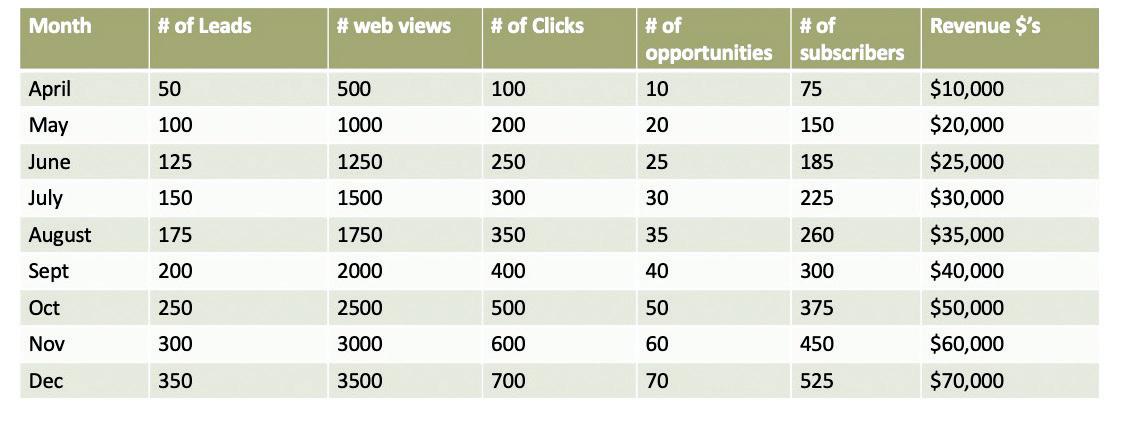
4 minute read
Is your marketing working? Part 1 How would you know?
Is your marketing working? Part 1
How would you know?
by Trip Jobe, CEO, Rand Inc.

If you haven’t developed scenario plans for marketing, don’t you think now’s the time?
The Pandemic has challenged all of our businesses and the way we think. If you weren’t in the habit of having scenario plans for the operational side or financial side of your business, I’m sure you do now. But most marketing departments and leaders think about marketing plans as an annual exercise and need time to play out before they develop a new plan. Why is marketing any different than supply chain or operations? It shouldn’t be! Let’s assume for now, that the reason marketers don’t develop scenario plans is they don’t know where to start. In this article, I will share some tips at a high level to get you started.
Step 1: Interim campaign goals.
You probably have annual goals for your campaign, which is super. But few businesses develop interim goals to reflect how and when they will get to a certain number of leads, opportunities, or deals. Start here, if not monthly then at least quarterly. The second part of this step is to then determine your guardrails for this chart, is it +/- 5%, 10%, 20%? Only you know the best percentage to discern if you are on or off track enough to initiate action. (Fig. 1)
Step 2: Alternative plans.
This step should be the easiest, but most companies don’t put together a list of alternatives until it’s too late and then they are in scramble mode. The reality is most of your original plans include marketing tactics that you chose not to execute. It may be due to budget or the audience focus, but you had other options. This is your starting point, always take your unused choices and begin your alternative plan list. The second part of this step is to then add some thoughts on who is the audience and at what stage of the funnel would these tactics impact your plan. (Fig. 2)
Step 3: Activate adjustments.
When do you pull the trigger on your adjustments? This is where the guardrails from the second part of Step 1 become critical. If we used a green, yellow, red matrix of our actuals to our forecasts, we can stay the course while in the green zone, begin to evaluate the need for adjustments while in the yellow, and act by the time we reach the red zone. One benefit is this also means staying on the positive side! I’ve been fortunate to work for CEOs who said they wanted to double down if something is working better than
expected. If not willing to grant more money, maybe you need to shift funds from underperforming tactics.
Step 4: Keep forecasting.
If you have gotten through Step 3, congratulations! You are way ahead of most of your competitors. This step will help you keep accelerating that distance. We believe that once you have set your targets and guidelines, and have the actual results that you need, you need to keep forecasting based on market conditions or adjustments that you made. What if you made changes to a poor performing tactic and saw immediate results that quickly got you back into the yellow or slight green zone of your original goals? That might sound great, but if you had reforecast, you might see that you were outperforming your goals. And if you get to that point, you should consider shifting more dollars into this program. Fig. 3 shows how reforecasting can help you. Scenario Plans are the key to staying out of Einstein’s insanity paradox of doing the same things over and over again. Steps 1-3 will help you create meaningful marketing improvements and step 4 is an advanced step. The past year has taught us the need to be nimble. To be nimble and successful, you must have adjustment ideas in place that you can act upon. Many companies that are forced to make sudden knee-jerk reactions, without a plan in place, ultimately regret those decisions. Take the time to build out your guardrails, alternatives, and points where you can be ready to adjust if needed. Not only will you be better prepared for the next challenging business situation, but you will also be prepared to boost your marketing efforts to take advantage of better-than-expected results!
Fig. 1: New Product Launch Goals

Fig. 2: New Product Launch Campaign Ideas

About the author
Trip is the CEO of Rand Inc., a strategic marketing and analytics firm. Having sat in both sales and marketing leadership roles for large and small firms for 20+ years, Trip is an ambassador for driving sales and marketing alignment to fuel growth.
Email: tjobe@randinc.cc Web: randinc.cc LinkedIn: www.linkedin.com/in/tripjobe
Fig. 3: New Product Launch
Opportunities Created











